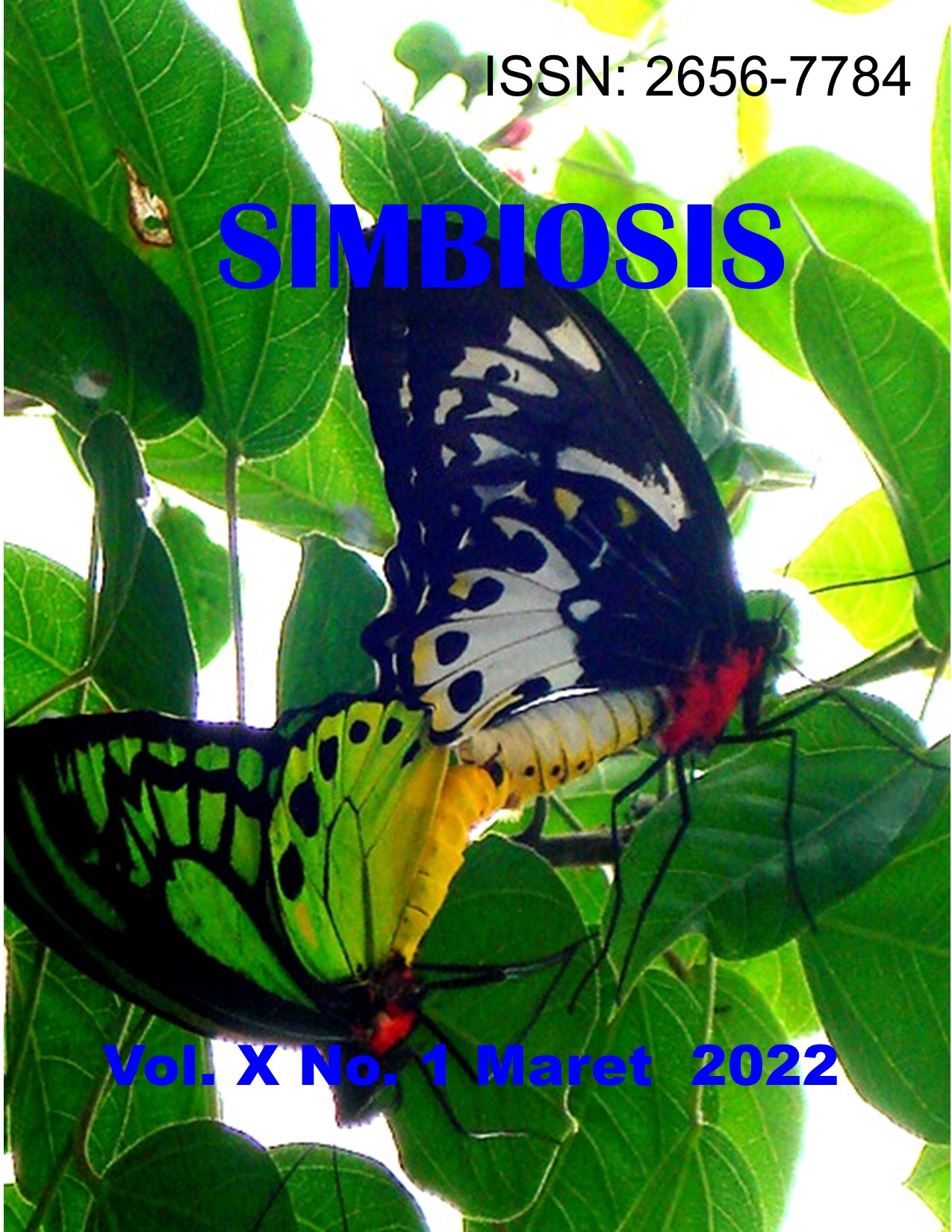BACTERIAL CONSORTIUM POTENCY FOR BIOREMEDIATION OF SEWAGE AT PESANGGARAN SLAUGHTTERHOUSE BALI
Abstract
Slaughterhouses produce solid waste and liquid waste. The liquid waste consists of urine, blood, fat, and carcass washing water which causes pollution to the environment if not treated in a good way. This study aims to determine the potential of a consortium of bacteria (Bacillus sp., Klebsiella sp.) in remediating the abattoir wastewater. This research was conducted from January to April 2021 at the Microbiology Laboratory of the Biology Study Program, Faculty of Mathematics and Natural Sciences, Udayana University, and the Analytical Laboratory of Udayana University, using the Sequence Batch Reactor (SBR) method, with the varying treatment of a consortium of bacteria concentration i.e 0 (as control), 10, 20, 30, 40, and 50 mL in 2 liters of liquid waste. Parameters observed were changes in physical parameters, BOD5, Total Plate Number (ALT), and nitrite and nitrate content of waste samples. The results of this study showed that treatment 5 is giving a bacterial consortium dose of 50 mL/2 liters of wastewater was the most effective dose with a BOD5 value of 0.82 g/L, clear yellow without odor, TDS Final Value 539.6 mg/L, and the number of bacteria 9.54 x 1010 and a decrease in nitrite and nitrate by -0.001 and 1.743 mg/L
Downloads
References
Darmayasa. I. B. G. 2008. Isolasi Dan Identifikasi Bakteri Pendegradasi Lipid (Lemak) Pada Beberapa Tempat Pembuangan Limbah Dan Estuari DAM Denpasar. Jurnal Bumi Lestari. 8 (2): 122-127
Holt, J. G., N. R. Krieg., P. H.A. Sneath., J. T. Staley., and S. T. Williams. 1994. Bergey’s Manual of Determinative Bacteriology 9th Edition. Williams and Wilkins. Baltimore, Maryland.
Ilmiah. S., A.A.G. Raka Dalem, dan I K Muksin. 2021. Pengelolaan sampah anorganik pada Alila Villas Uluwatu, Bali. Jurnal Biologi Udayana. 25(1): 83-91
Lizayana· Mudatsir, Iswad. 2016. Densitas Bakteri pada Limbah Cair Pasar Tradisional. Jurnal Ilmiah Mahasiswa Pendidikan Biologi. 1 (1): 95-106.
Okoh., A. I. 2006. Biodegradation alternative in the cleanup of petroleum hydrocarbon pollutants, Biotechnol and Molecular Biology Review 1 (2): 38-50.
Oktavia, D. A., Mangunwidjaja, D., Wibowo, S., Sunarti, T. C., & Rahayuningsih, M. 2012. Pengolahan limbah cair perikanan menggunakan konsosrsium mikroba indigenousproteolitik dan lipolitik. Agrointek, 6(2), 65-71.
Peraturan Menteri Lingkungan Hidup. 2014. Keputusan Menteri Lingkungan Hidup Nomor 5 Pedoman Penetapan Daya Tampung beban Pencemaran Air pada Sumber Air. Kementrian Lingkungan Hidup. Jakarta.
Priadie. B. 2012. Teknik bioremediasi sebagai alternatif dalam upaya pengendalian pencemaran air. Jurnal Ilmu Lingkungan.10(1): 38-48
Rachma, R., I. W. R., Aryanta., I. W. Kasa. 2012. Penggunaan lumpur aktif untuk menurunkan kadar Biological Oxygen Demand (BOD), Chemical Oxygen Demand (COD), dan Logam Berat jenis Timbal (Pb) dan Cadmium (Cd) pada limbah cair pencelupan industri batik. ECOTROPHIC. 7 (2): 164 – 172.
Rinawati. Diky. H. R. Suprianto. Putri.S.D. 2016. Penentuan Kandungan Zat Padat (Total Dissolve Solid dan Total Suspended Solid) di Perairan Teluk Lampung. Analit: Analytical and Environmental Chemistry. 1 (1): 36-45
Sepyana, I., Ganjar samodro., dan Mochtar Hadiwidodo.2013. Pengaruh Variasi Debit Dan Jumlah Elektroda Terhadap Penurunan Cod Dan Produksi Listrik Dalam Reaktor Microbial Fuel Cells (Mfcs). Jurnal Teknik. Undip.1 (1): 44-48
Suardana IW. 2007. Karakterisasi limbah cair rumah potong hewan pesanggaran. Jurnal Anim Prod.:9(2):116–122.
Suryahadi, Nugraha A R, Bey A, dan Boer R. 2010. Laju konversimetan dan faktor emisi metan pada kerbau yang diberi ragi tape lokal yang berbeda kadarnya yang mengandung Saccharomyces cerevisiae. Ringkasan Seminar Program Pascasarjana IPB.
Taroreh. L.R., Ferry. K dan Jubhar. M. 2016. Transformasi Nitrogen secara Biologis di Air Panas Sarongsong Kota Tomohon. Prosiding Seminar Nasional Teknik Kimia “Kejuangan”.
Waluyo, L. 2005. Mikrobiologi Lingkungan. Malang: UMM Press.

This work is licensed under a Creative Commons Attribution 4.0 International License.










